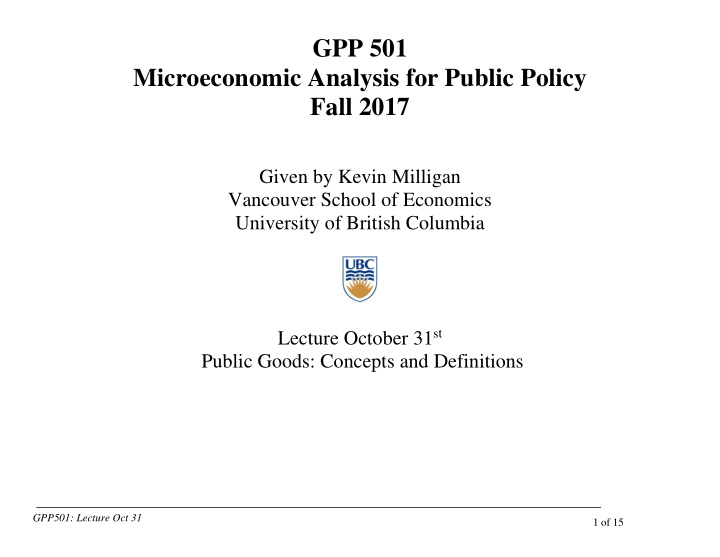



GPP 501 Microeconomic Analysis for Public Policy Fall 2017 Given by Kevin Milligan Vancouver School of Economics University of British Columbia Lecture October 31 st Public Goods: Concepts and Definitions GPP501: Lecture Oct 31 1 of 15
Agenda 1. Concepts and definitions 2. The case of lighthouses 3. Examples GPP501: Lecture Oct 31 2 of 15
Public Goods: The Concept What’s the difference? GPP501: Lecture Oct 31 3 of 15
Public Goods: Rivalry Does amount that I consume affect what others can consume? Can you think of any examples? What limits non-rivalry? GPP501: Lecture Oct 31 4 of 15
Public Goods: Definition of Rivalry Paul Samuelson: “…one [person]’s consumption does not reduce some other [person] ’s consumption.” Q: How does this affect society’s decision of how much to produce? Q: How does this contrast with a good that is non- rival? GPP501: Lecture Oct 31 5 of 15
Public Goods: Excludability Can I stop people who haven’t paid from enjoying the good? Can you think of any examples? What limits excludability? GPP501: Lecture Oct 31 6 of 15
Public Goods: Definition of Excludability Gareth Myles, University of Adelaide “If the public good is supplied, no household can be excluded from consuming it, except possibly at infinite cost.” Q: How does this affect production of goods? GPP501: Lecture Oct 31 7 of 15
Public Goods: Excludability and Non-rivalry Non-Rival Rival Non-Excludable Excludable GPP501: Lecture Oct 31 8 of 15
Agenda 1. Concepts and definitions 2. The case of lighthouses 3. Examples GPP501: Lecture Oct 31 9 of 15
The Lighthouse: A public good? A very typical example used in textbooks for a long time…. John Stuart Mill: “It is a proper office of government to build and maintain lighthouses…” Arthur Pigou: for a lighthouse, “marginal net product falls short of marginal social net product” Paul Samuelson on lighthouses: “Philosophers and statesmen have always recognized the necessary role of government in such cases…” GPP501: Lecture Oct 31 10 of 15
The Lighthouse: A public good? Q: How does a lighthouse fit in this excludable / rival framework? Rival? Excludable? GPP501: Lecture Oct 31 11 of 15
The Lighthouse: Coase’s criticism… https://www.jstor.org/stable/724895 In England, there was a long history of ‘private’ lighthouses, operated on patent from the Crown independently, or through Trinity House, a corporation chartered in 1514. Bu t… • You needed Crown permission to build. • Mandatory tolls (“light dues”) collected by customs officials. Coase argued: see, just need government to enforce property rights by ensuring price can be charged. Counterpoint : this wasn’t a ‘free market’ solution; it’s a regulated and enforced monopoly. GPP501: Lecture Oct 31 12 of 15
Agenda 1. Concepts and definitions 2. The case of lighthouses 3. Examples GPP501: Lecture Oct 31 13 of 15
Examples to consider: i. Education ii. Public health iii. Policing / crime prevention iv. Scientific research/discoveries v. Printed word — books, writing, etc. vi. Environmental protection vii. Transportation infrastructure viii. Charitable goods / poverty alleviation ix. Incarceration x. Water / sewage provision GPP501: Lecture Oct 31 14 of 15
Happy Halloween! GPP501: Lecture Oct 31 15 of 15
Recommend
More recommend